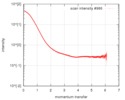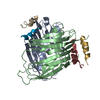+Search query
-Structure paper
| Title | Structures of insect Imp-L2 suggest an alternative strategy for regulating the bioavailability of insulin-like hormones. |
|---|---|
| Journal, issue, pages | Nat Commun, Vol. 9, Issue 1, Page 3860, Year 2018 |
| Publish date | Sep 21, 2018 |
 Authors Authors | Nikolaj Kulahin Roed / Cristina M Viola / Ole Kristensen / Gerd Schluckebier / Mathias Norrman / Waseem Sajid / John D Wade / Asser Sloth Andersen / Claus Kristensen / Timothy R Ganderton / Johan P Turkenburg / Pierre De Meyts / Andrzej M Brzozowski /     |
| PubMed Abstract | The insulin/insulin-like growth factor signalling axis is an evolutionary ancient and highly conserved hormonal system involved in the regulation of metabolism, growth and lifespan in animals. Human ...The insulin/insulin-like growth factor signalling axis is an evolutionary ancient and highly conserved hormonal system involved in the regulation of metabolism, growth and lifespan in animals. Human insulin is stored in the pancreas, while insulin-like growth factor-1 (IGF-1) is maintained in blood in complexes with IGF-binding proteins (IGFBP1-6). Insect insulin-like polypeptide binding proteins (IBPs) have been considered as IGFBP-like structural and functional homologues. Here, we report structures of the Drosophila IBP Imp-L2 in its free form and bound to Drosophila insulin-like peptide 5 and human IGF-1. Imp-L2 contains two immunoglobulin-like fold domains and its architecture is unrelated to human IGFBPs, suggesting a distinct strategy for bioavailability regulation of insulin-like hormones. Similar hormone binding modes may exist in other insect vectors, as the IBP sequences are highly conserved. Therefore, these findings may open research routes towards a rational interference of transmission of diseases such as malaria, dengue and yellow fevers. |
 External links External links |  Nat Commun / Nat Commun /  PubMed:30242155 / PubMed:30242155 /  PubMed Central PubMed Central |
| Methods | SAS (X-ray synchrotron) / X-ray diffraction |
| Resolution | 2.57 - 3.48 Å |
| Structure data |  SASDDS8: Neural/ectodermal development factor IMP-L2 (Imp-L2 IBP)  SASDDT8: Neural/ectodermal development factor IMP-L2 in complex with insulin-like peptide 5 (DILP5)  PDB-6fey:  PDB-6ff3: |
| Chemicals |  ChemComp-HOH: |
| Source |
|
 Keywords Keywords | PEPTIDE BINDING PROTEIN / insulin / insulin binding protein / Drosophila / imaginal morphogenesis / IGF-I |
 Movie
Movie Controller
Controller Structure viewers
Structure viewers About Yorodumi Papers
About Yorodumi Papers




 homo sapiens (human)
homo sapiens (human)